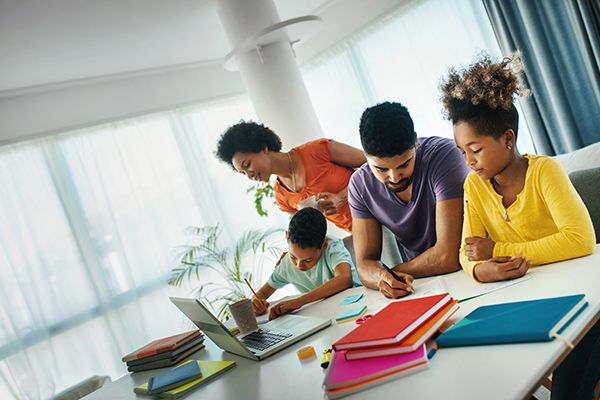In this second part of the series on pandemic learning, Senior Learning Scientist, Dr. Annie Snyder, continues the discussion about students, teachers, parents, and caregivers adjusting to remote learning while embracing the challenges and opportunities that may arise.
Our question: How can parents and caregivers help children treat home like school?
Perhaps the best way to answer this question is to let go of the idea that home needs to turn into school. More specifically, parents and caregivers do not need to try to replicate a child’s exact school experience at home (just like teachers do not try to make a school setting exactly like home).
Instead, it is okay for everyone to embrace the new “pandemic learning” model for exactly what it is: a flexible, hybrid, ever-evolving situation. Parents, caregivers, teachers, and learners don’t need to turn home into school, but rather, to creatively combine the best features of both whenever possible.
While there is no guidebook (yet!) about how to best go about pandemic learning, there are a few tips that we can borrow from educators to help children continue learning in their new hybrid home/school environment:
Play:
The act of playing is vital for all humans, not just the very young. In fact, very rich cognitive, social, and emotional growth can take place during play among children of all ages. Many teachers from preschool and up strive to find ways to incorporate playful learning into the day through game-based instruction, physical activity, and engagement with toys and manipulatives. During times of hardship and transition, playing becomes especially important as children use play activities as outlets for processing their experiences. Parents and caregivers can harness the power of play by providing regular opportunities for both structured (“let’s play checkers!”) and unstructured (here’s some playdough - what are you going to make?”) throughout the day.
Structure:
On the flipside, the typical school setting is often relatively structured around academics. To support academic learning at school, teachers often provide visual guidelines, directions, checklists, and written schedules to help students stay on track. The same tools can be used by parents and caregivers at home to help kids remain focused and understand what they are supposed to be doing, even if learning activities are spread out throughout the day. For younger children, picture schedules are especially useful – you can use sticky notes or small pieces of paper, or even doodles to illustrate when it is time to read a book, have snack, play, try a math task, and so on.
Check for Understanding:
With a busy classroom full of students, teachers are still responsible for ensuring students understand the content that was taught as well as what is expected of students. Asking kids to repeat instructions, retell their understanding of a learning task, or otherwise replicate an aspect of the learning experience, can all help kids build up their listening skills and can also help parents understand where there may be misunderstandings. This sort of feedback loop is critical for any learning experience, whether it happens at home or not.
Act:
Great teachers often talk about how the classroom is like a stage, complete with actors, an audience, props, improvisation, and even opening-day jitters! While this may not exactly hold true at home, learners and their parents can still use roleplaying and drama to practice perspective-taking, problem-solving, and flexible thinking. Dramatic play can also be used for conflict resolution. For example, if a child takes on the role of the “teacher” while the parent becomes the “student,” both child and parent can use this opportunity to roleplay some of the challenges that have surfaced throughout the day (e.g. not following directions, losing focus, sneaking off to watch YouTube, etc.). This not only helps everyone gain perspective, but it’s also pretty funny!
Parent First, Teach Second:
Remember that parents and caregivers have always served as teachers for their children. In fact, the parent/child relationship is one of the richest social learning dynamics in the entire human experience, and not even a pandemic can change this. As many educators themselves are tackling homeschooling and simultaneous distance teaching, they are suggesting that we follow the mantra of “parent first, teach second.” This mindset can help maintain a focus on family while also supporting ongoing learning.
All told, it can be helpful to keep in mind that we are all in the midst of a new experiment in home learning. Never before have we had such widescale distance learning, not only in terms of geographic spread, but also in terms of age span. While online learning has become a relatively common facet of higher education, full-time distance instruction is a relative rarity in K-12. Together, the world is discovering new ways of playing, communicating, teaching, and learning, even if it is different than what we knew before. Most important of all, both children and those who love them should always remember that even though we may be social distancing, we can always learn together.
